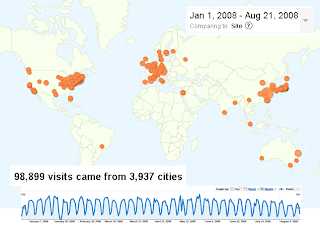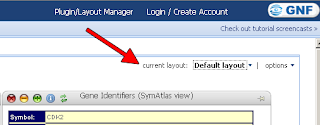 We know that we have a pretty loyal base of SymAtlas users. And it’s because of that knowledge that we don’t tread lightly on making changes to this well-used resource.
We know that we have a pretty loyal base of SymAtlas users. And it’s because of that knowledge that we don’t tread lightly on making changes to this well-used resource.
But SymAtlas is getting a bit long in the tooth, and at some point in the foreseeable future it will have to be retired. Thankfully, we’ve been planning its successor for quite some time, and that successor is BioGPS. The goal of BioGPS is pretty much the same, to provide an integrated portal which displays gene-centric annotation, including “annotation” based on reference gene expression data sets. To make the transition easier, we’ve tried to preserve the look and feel of the SymAtlas interface.
 BioGPS also introduces some pretty cool new functionality. For example, most gene portals present gene reports to you in a way that reflects their own view of gene function. But BioGPS recognizes that molecular biologists are interested in different things than structural biologists, and human geneticists have different sources of data than mouse geneticists. Therefore, BioGPS allows each user to customize their gene report layout to correspond to how they want to see gene annotation.
BioGPS also introduces some pretty cool new functionality. For example, most gene portals present gene reports to you in a way that reflects their own view of gene function. But BioGPS recognizes that molecular biologists are interested in different things than structural biologists, and human geneticists have different sources of data than mouse geneticists. Therefore, BioGPS allows each user to customize their gene report layout to correspond to how they want to see gene annotation.
To showcase this functionality, we’ve created a few default “layouts” that you can play around with. And yes, each plugin is contained in an independent window that can be moved and resized as you see fit. (You’ll need to sign up for a BioGPS account to save custom layouts.) Play around with it and let us know what you think…
 We’ve also added new data sets that aren’t available in SymAtlas. In particular, check out the updated mouse GeneAtlas data set on the newer MOE430 chip, and also the mouse exon array atlas.
We’ve also added new data sets that aren’t available in SymAtlas. In particular, check out the updated mouse GeneAtlas data set on the newer MOE430 chip, and also the mouse exon array atlas.
We want people to transition from SymAtlas to BioGPS on their own schedule, so we’re keeping both sites open for the time being. But eventually, SymAtlas will be retired. So if there’s a reason that you’re still clinging to SymAtlas we want to know why, and we’ll do our best to make BioGPS the better solution in all respects.

With Symatlas it was possible to search for genes with an expession profile correlated to the query. I do not see this option in BioGPS. Doesn’t BioGPS have this feature or have I not found it yet?
Hello anonymous, yes, you’ve hit the nail on the head on that one. Search by expression (or search by correlation) are features we have yet to implement in BioGPS. There was some question as to how much those features are used in SymAtlas, and every time someone asks about it, it bumps that a bit up the BioGPS priority list. Anyway, bump noted…
I too would like to bump the search by expression feature up. I find that feature very useful and would hate for it to be lost in the BioGPS.
Thanks anonymous, your vote has been tallied as well. Look for the return of this feature sometime later this year (sooner if we can). Keep the feedback coming…
Hi Andrew, I like the Exon array Gene Atlas plugin but a utility of it is limited due to lack of links to probes/probesets description. You wrote “Data from our exon array Gene Atlas”, therefore is it possible to get information about the probes used in the arrays? Additionally, can you add a new plugin links to a web-page of EBI (http://www.ebi.ac.uk/asd/) on Alternative Splicing Database Project? Linking the data from two resources would be advantages.
I like the expression feature from SymAtlas too, especially possibility of combining results (union with previous/ intersect with previous). Please do not retire SymAtlas yet. Now your both pages seems to be complementary. All the best,
Chris
Hi Chris, I responded to your query over here. Cheers! -andrew
Yet another vote for the correlation feature of Symatlas, please – though we don’t use this as often as simple searches, there are times when it is critical to find genes we otherwise wouldn’t have thought of. We currently have an entire project that resulted from one of these correlation searches. By its nature it is less used (numerically) but this doesn’t mean it is less important.
Hi Ian, thanks for your comment, and your feedback (combined with the feedback of others) has been heard loud and clear. Correlation searching has been added to our development path, and we won’t retire SymAtlas until that functionality is in BioGPS. Just as one added note, there are a couple data sets that are in BioGPS but not in SymAtlas. If you need to do correlation searching on those data sets, you are always free to download the raw data sets and do the correlations in R or Excel. Yes, less convenient, but a passable work-around in the mean time.
Cheers,
-andrew
Lest you folks put expression query capability low on your priority list, I also use it routinely. In fact, we’ve published work using it (PMID: 17971504).
Tim,
Thanks for your feedback, and I'm glad our web site and data were useful to you for your paper.
Of the two search functions based on expression data, "search by correlation" is currently the higher priority relative to "search by expression". (To clarify, the former searches for similar patterns to some existing gene expression profile, while the latter works on specific filtering criteria like "expressed in heart > 5 times median".)
The current prioritization is based on the comments here and elsewhere suggesting that correlation search is more widely used. Also, the filtering-based search can also be done relatively easily by downloading the raw data.
Having said all that though, Tim, your input is noted. And if anyone else strongly agrees with Tim, let us know!
Cheers,
-andrew
Any update on when find correlated might be available in BioGPS? Symatlas seems to be dead at the moment but I can’t find the functionality in BioGPS. Maybe I’m missing it…
Anonymous, Right now, I can say that we’re actively working on search by correlation as one of our top priorities. A firm timeline however is not available.
SymAtlas is now back up again for your correlation searching needs. Thanks for letting us know about the outage, and free to post here or to the BioGPS help group whenever you notice any unusual SymAtlas behavior in the future.
Cheers,
-andrew